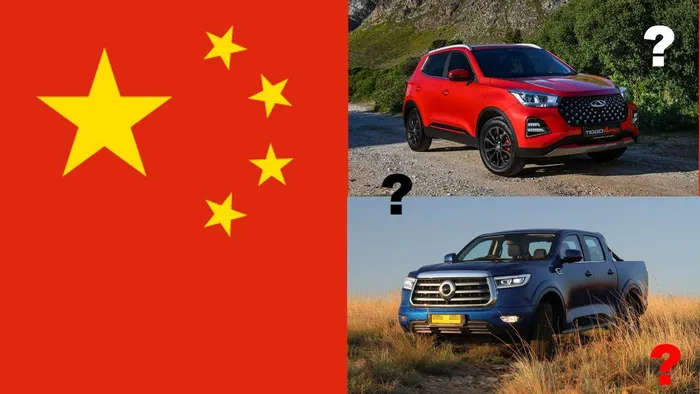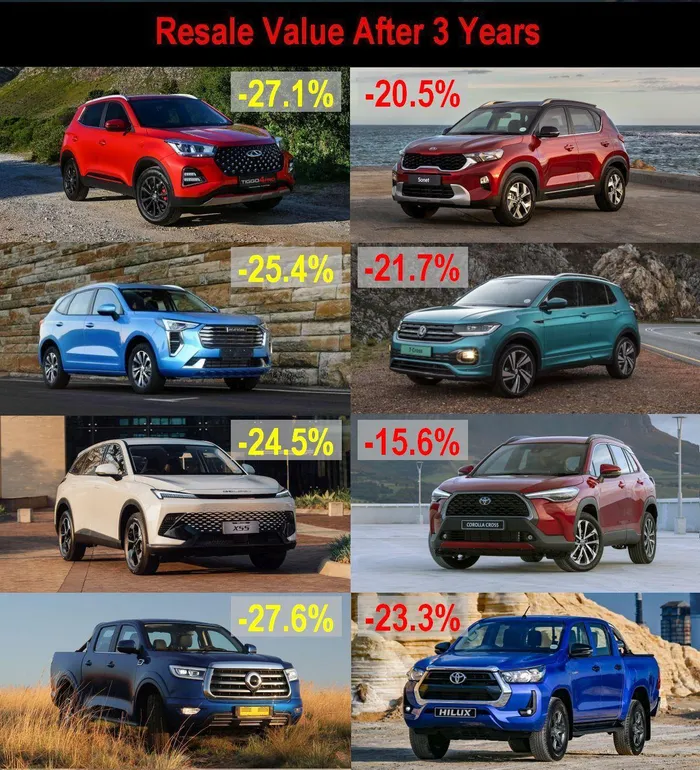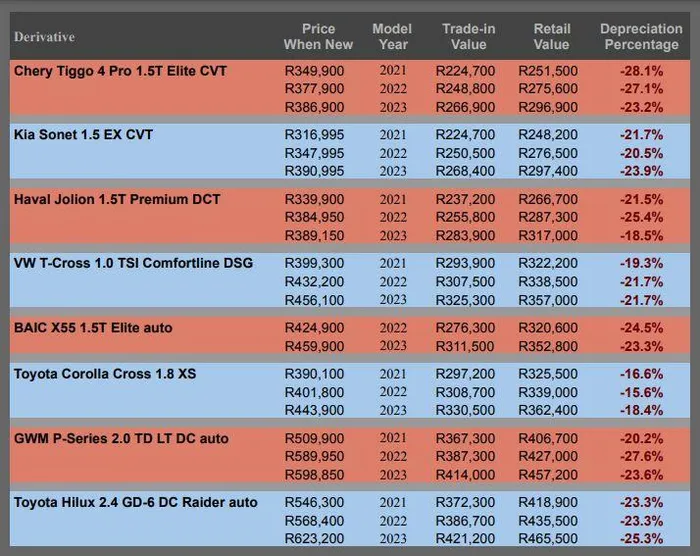How well do Chinese cars hold their value after three to four years? Here’s what the 'book' values show

Some of South Africa's most popular Chinese vehicles have been around for four years now. But how much are they worth on the used market?
Image: Jason Woosey
Chinese vehicles have become irresistible to many South African vehicle buyers, thanks to pricing that often significantly undercuts the established brands and feature-packed interiors that belie those very tempting price tags.
Chery and GWM are now regular fixtures on the top 10 vehicle sales charts, and their Tiggo 4 and Haval Jolion models are among the best-selling SUVs in the country.
Naturally, there has also been a rise in demand for Chinese vehicles on the used car market, with AutoTrader’s latest Mid-Year Report showing that searches for Chinese vehicles grew by 69% in the first half of 2025, while enquiries grew by 81%.
But how well have Chinese vehicles held their value over the years?
As most Chinese brands are relatively new to the market, this has been a difficult factor to quantify. However, as of late 2025, some of the best-selling models have been on the market for three to four years.
To gain further insight, IOL drew 'book values' from TransUnion’s Vehicle Valuations Database, which is a subscription service widely used by vehicle dealerships to determine the trade-in, residual and retail values of used vehicles in South Africa.
As a basis for comparison, we also included a small sample of products from established car manufacturers, such as Toyota, Volkswagen and Kia.
The results were a mixed bag, and while the Chinese vehicles generally fared worse than their competitors, it wasn't always by the largest of margins.

Percentage of depreciation on 2022 models versus their retail prices when new.
Image: Jason Woosey
Chery’s Tiggo 4 Pro Elite CVT showed the steepest depreciation curve among the field, with 2021 models having lost 28.1% of their value in four years, while 2022 models depreciated by 27.1% in three years, versus the Kia Sonet EX's depreciation of 21.7% (four years) and 20.5% (three years).
The Haval Jolion fared a little better, with the 2022 sample model losing 21.5% of its value in four years and 25.4% of its value in three years, albeit still beaten by the Volkswagen T-Cross, at 19.3% and 21.7% respectively.
In the midsize category, the Toyota Corolla Cross wins by a lofty margin, with 2022 1.8 XS models losing just 15.6% of their value over three years, versus 24.5% for the BAIC X55 Elite auto.

Used car 'book value' data supplied by TransUnion. Depreciation percentages are based on the used retail value versus price when new.
Image: Jason Woosey
On the bakkie scene, it was a closer tug of war, with the GWM P-Series LT double cab losing 27% after three years and the Toyota Hilux Raider giving up 23.3%. Interestingly, the 2021 GWM lost just 20.2% of its value over four years, but that figure is skewed by the ‘new’ price being much lower in 2021 than it was in 2022.
What about trade-in values?
Since many South Africans trade in their vehicles rather than selling privately, trade-in values should also be taken into consideration. In that regard, the Toyota Corolla Cross trumps, losing 23.2% of its value over three years, versus the new list price in 2022. It is followed by the Kia Sonet (28.0%), VW T-Cross (28.8%), Toyota Hilux (31.9%), Haval Jolion (33.5%), Chery Tiggo 4 (34.1%), GWM P-Series (34.3%) and BAIC X55 (34.9%).
While the TransUnion data of our albeit small sample shows that Chinese cars still depreciate, on average, at a faster rate than vehicles from established brands, that gap is not as significant as one might have expected, and there is every chance it could narrow once demand for these vehicles increases on the used market. However, this used value deficit should still be taken into consideration when you're considering buying a new Chinese vehicle.
Exceptional value either way
"The TransUnion Mobility Insights Q2 2025 study confirms what many dealers already know: affordability trumps aspiration," said Lee Naik, CEO of TransUnion Africa.
"South African consumers are prioritising total cost of ownership and value, with Chinese OEMs expanding their market share from 3.1% in 2022 to nearly 15% in Q2, 2025. But the growth story lies in SUV-heavy, tech-rich, price-sharpened models."
Their well-priced and high-tech SUVs, along with constantly expanding dealer networks, are reshaping competition and forcing established carmakers to rethink their pricing policies as well as features and model cycles, Naik added.
Chinese vehicles have indeed created a structural shift in the South African vehicle market, AutoTrader CEO George Mienie added.
“Chinese automakers have found a way to deliver exceptional value at a fraction of the traditional cost, offering roughly 80% of what buyers expect for only 60% of the price. That’s changing what South Africans consider possible when it comes to affordability and technology. The bigger story is how this is reshaping competition and setting new benchmarks that all automakers will have to meet.”
* Disclaimer: Although the TransUnion 'book' values are regarded as the most credible source of used vehicle value estimations, bear in mind that there are many variables involved that could determine the actual value of individual cars on the used market. These include regional demand and supply patterns as well as factors such as mileage and condition.
** Special thanks to TransUnion for the used vehicle data supplied.
Get your news on the go. Download the latest IOL App for Android and IOS now
IOL Motoring